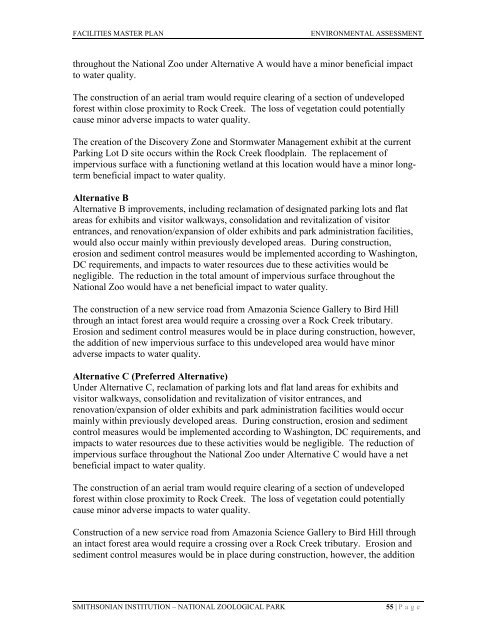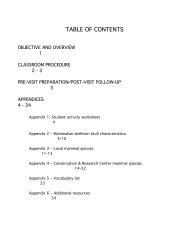facilities renewal master plan - National Zoo - Smithsonian Institution
facilities renewal master plan - National Zoo - Smithsonian Institution
facilities renewal master plan - National Zoo - Smithsonian Institution
Create successful ePaper yourself
Turn your PDF publications into a flip-book with our unique Google optimized e-Paper software.
FACILITIES MASTER PLAN ENVIRONMENTAL ASSESSMENT<br />
throughout the <strong>National</strong> <strong>Zoo</strong> under Alternative A would have a minor beneficial impact<br />
to water quality.<br />
The construction of an aerial tram would require clearing of a section of undeveloped<br />
forest within close proximity to Rock Creek. The loss of vegetation could potentially<br />
cause minor adverse impacts to water quality.<br />
The creation of the Discovery Zone and Stormwater Management exhibit at the current<br />
Parking Lot D site occurs within the Rock Creek floodplain. The replacement of<br />
impervious surface with a functioning wetland at this location would have a minor longterm<br />
beneficial impact to water quality.<br />
Alternative B<br />
Alternative B improvements, including reclamation of designated parking lots and flat<br />
areas for exhibits and visitor walkways, consolidation and revitalization of visitor<br />
entrances, and renovation/expansion of older exhibits and park administration <strong>facilities</strong>,<br />
would also occur mainly within previously developed areas. During construction,<br />
erosion and sediment control measures would be implemented according to Washington,<br />
DC requirements, and impacts to water resources due to these activities would be<br />
negligible. The reduction in the total amount of impervious surface throughout the<br />
<strong>National</strong> <strong>Zoo</strong> would have a net beneficial impact to water quality.<br />
The construction of a new service road from Amazonia Science Gallery to Bird Hill<br />
through an intact forest area would require a crossing over a Rock Creek tributary.<br />
Erosion and sediment control measures would be in place during construction, however,<br />
the addition of new impervious surface to this undeveloped area would have minor<br />
adverse impacts to water quality.<br />
Alternative C (Preferred Alternative)<br />
Under Alternative C, reclamation of parking lots and flat land areas for exhibits and<br />
visitor walkways, consolidation and revitalization of visitor entrances, and<br />
renovation/expansion of older exhibits and park administration <strong>facilities</strong> would occur<br />
mainly within previously developed areas. During construction, erosion and sediment<br />
control measures would be implemented according to Washington, DC requirements, and<br />
impacts to water resources due to these activities would be negligible. The reduction of<br />
impervious surface throughout the <strong>National</strong> <strong>Zoo</strong> under Alternative C would have a net<br />
beneficial impact to water quality.<br />
The construction of an aerial tram would require clearing of a section of undeveloped<br />
forest within close proximity to Rock Creek. The loss of vegetation could potentially<br />
cause minor adverse impacts to water quality.<br />
Construction of a new service road from Amazonia Science Gallery to Bird Hill through<br />
an intact forest area would require a crossing over a Rock Creek tributary. Erosion and<br />
sediment control measures would be in place during construction, however, the addition<br />
SMITHSONIAN INSTITUTION – NATIONAL ZOOLOGICAL PARK 55 | P a g e

















